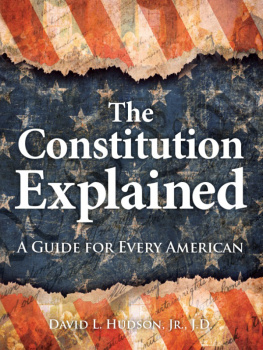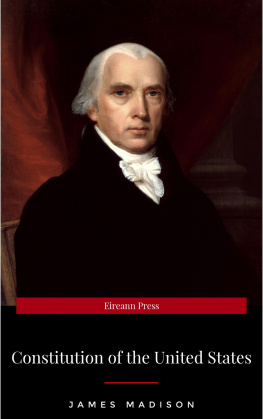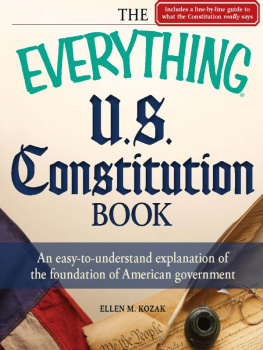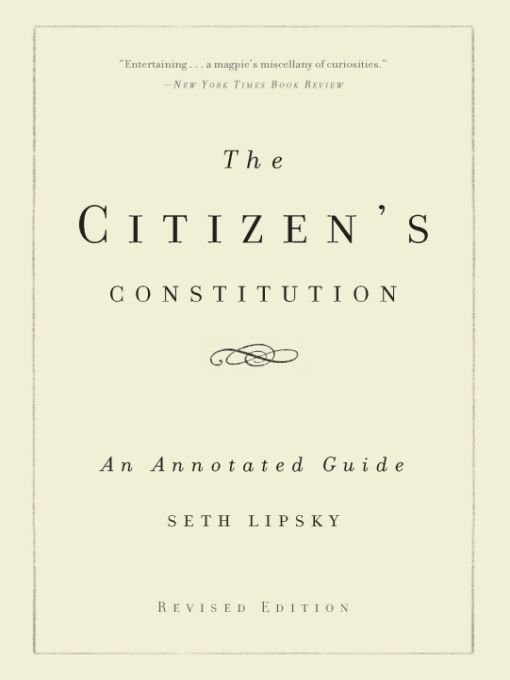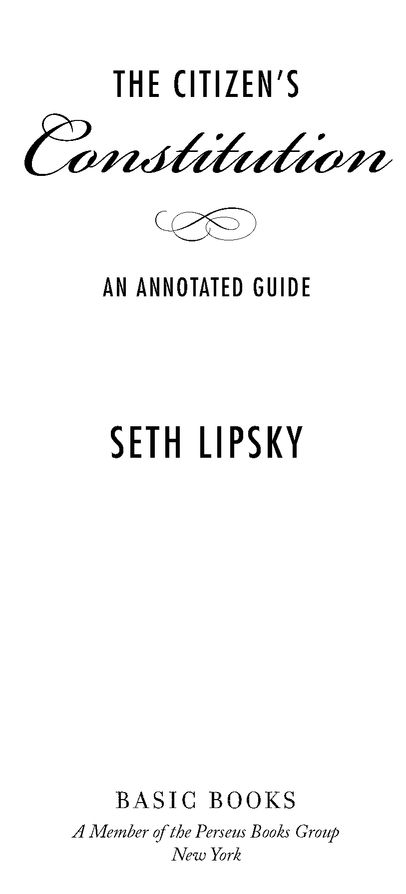Table of Contents
IN MEMORY OF MY FATHER
KARL LIPSKY
PREFACE

The enthusiasm that has greeted The Citizens Constitution is no doubt related to the fact that our country is in what might be called a constitutional moment. Almost every week a new story bursts into the headlines. Nearly half the states in the union are challenging the constitutionality of a new national health care plan. Gyrating world currency markets are igniting a debate over the constitutional meaning of money. Arizona is precipitating a showdown with the federal government over who controls immigration. Our courtsand our newspaper columnsare crackling with the question of habeas corpus. The states are wrestling with whether to permit the laws of marriage to comprise same-sex unions. Technology is making it possible for our privacy to be invaded in ways undreamed of in the past. The Supreme Courts decision to vouchsafe the rights of a conservative group to air a film critical of a Senate candidate during the election season is triggering a bitter debate over whether corporations and organizations should guaranteed free speech. Every one of these issues, and countless more, will be worked out with reference to a parchment of fewer than eight thousand words, written, for the most part, ten generations ago.
Yet the excitement of the moment was not what originally inspired the present volume. It grew slowly during my forty years as newspaper editor, a career in which I presided at thousands of daily editorial meetings, hardly one of which passed without at least a reference to some provision of the document that has established our system of checks and balances. It is a career that has left me astonished at the scale and range of problems that can be, and so often are, reasoned out against the clauses of our national lawwhether it be a boat owner in Pennsylvania seeking the right to oysters in the beds of New Jersey, a foreign diplomat in Ohio trying to prevent his American wife from winning a divorce, or a retired security guard wanting to keep a pistol at his hometo name but a few of the situations in which ordinary individuals sought to solve a problem by turning to a law written by giants long before they were born.
The need for a laymans edition of the Constitution struck me one day when I pulled out the pocket edition that had been published by the commission the government established for the 200th anniversary of the signing. Nor did the pocket edition contain any reference to case law, to the intentions of the founders, or to the actions of Congress that might illuminate the point about privacy that had come under dispute.
At the time I could have consulted the edition of the Constitution containing an analysis, interpretation, and annotation of cases prepared by the Congressional Research Service of the Library of Congress and issued by the Government Printing Office. But that volume, which runs to some two thousand pages, wasnt handy; even had it been, Id have found that, like Edward Corwins classic edition, what it contains is more helpful to a legal scholar than to a layman. Another magnificent compendium, The Founders Constitution, compiled by Professors Kurland and Lerner of the University of Chicago, runs to five volumes, though it has become more accessible in recent years in a paperback edition from the Liberty Fund. It would have been difficult to have these volumes at hand when, a year or so later, I was trying to ex plain to a European friend the reason that gun control is not such an easy question in America.
Another conversation that left me in need of this book concerned the gold standard, which has been back in the news in the midst of a global financial crisis that has heard a number of leaders call for the establishment of a new world currency. It was easy to discover that the word gold occurs once in the Constitution it was less easy to discover what kind of intent lay behind, and what kind of experience lay in front of, the famous phrasing concerning the obligations of the states. In the course of answering that riddle I found myself consulting half a dozen books when I would have preferred to rely on only one. And what did the authors of the Constitution mean by the word dollars, which is used twice in the document? These are the sorts of questions a newspaper editor can encounter.
So I set out to produce the present volume. It differs from other annotations in that it is a citizens guidea view of the Constitution by an editor who hews to what might be called the plain language school of the law. It distills into notes a reading of the standard texts surrounding the Constitution. These include the several records kept of the Convention held at Philadelphia that sweltering summer of 1787, among them James Madisons notes, Justice Yatess Secret Proceedings, and Luther Martins marvelous memo to the legislature of Maryland, The Genuine Information. These also include the letters and journalism hammered out during the referenda held in the thirteen states of the young Confederation on whether to ratify the document. Of this material, the Federalist Papers, written under the pen name Publius, are the most famous, but there are myriad others, all illuminating intent. Experience is reported and ruled upon in the opinions of the high court. These form the Himalayas of legal precedent in whose foothills we hoe the vines of liberty.
This volume leavens these weighty references with a careers worth of reading and reporting the news at home and abroada marbling of the constitutional cake, so to speak, with a newspapermans batter. It does not always focus on the definitive decisions of the Supreme Court, though an effort has been made to touch on the main ones. Sometimes interest was piqued by the newsworthiness or the irony or the humor of a case. It was not surprising to discover the relevance of the arguments of the partisans of the Constitution to what we are talking about today. What was surprising was the relevance of the arguments put forward by the opponents of the Constitution, the so-called Anti-Federalists. We tend to think of the newspaper columns written to win the toughest ratification fight as works of surpassing wisdom. It turns out that James Madison, Alexander Hamilton, John Jay, and the boysmeaning the Federalistscould be slippery characters, offering with regard to the rights of the states reassurances that look, two centuries later, almost disingenuous. The Constitutional Convention itself was held in such secrecy that George Washington upbraided his fellow delegates when one of them dropped a scrap of paper on the floor.
To a surprising degree the matters that were disputed then are still being fought over today. Some say that the openness of the Constitution to interpretation is its greatest feature. They thrill to it as a living document. Life is constantly breathed into it anew, and not only by judges and lawyers and congressmen and presidents. Yet others say that the Constitutions greatest strength is its immutabilitythe notion that it sets a standard against which our laws can be measured. Certainly both sides agree that much constitutional work remains to be done. The Bill of Rights, when ratified, applied only to the Congress. It did not apply to the states. It was not until the Fourteenth Amendment that the process of incorporating its protections to the states was permitteda process that for more than a century has been taking place in scores of cases in scores of courtrooms and is far from completed.


